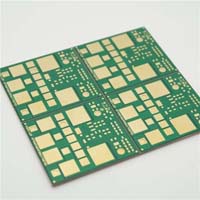Printed Circuit Boards
Heavy Copper 5OZ Thick Copper Printed Circuit Board Production
- heavy copper pcb
- 5OZ pcb
- thick copper pcb
- 4 layer pcb
- Product description: Heavy Copper 5OZ Thick Copper Printed Circuit Board Production
Heavy Copper 5OZ Thick Copper printed circuit board Production
Quick Detail:
|
Material |
Fr4 |
Name |
Heavy copper pcb |
|
Thickness |
3.3CM |
Layer |
4 |
|
Surface |
ENIG |
Key words |
Thick copper pcb |
|
Copper |
5OZ |
Brand |
ONESEINE |
Where are printed circuit boards used?
A printed circuit board, or PCB, is used to mechanically support and electrically connect electronic components using conductive pathways, tracks or signal traces etched from copper sheets laminated onto a non-conductive substrate.
Printed Circuit Board Production:
printed circuit boards (PCBs) are the boards that are used as the base in most electronics – both as a physical support piece and as the wiring area for the surface-mounted and socketed components. PCBs are most commonly made out of fiberglass, composite epoxy, or another composite material.
Most PCBs for simple electronics are simple and composed of only a single layer. More sophisticated hardware such as computer graphics cards or motherboards can have multiple layers, sometimes up to twelve.
Although PCBs are most often associated with computers, they can be found in many other electronic devices, such as TVs, Radios, Digital cameras and Cell phones. In addition to their use in consumer electronics and computers, different types of PCBs are used in a variety of other fields, including:
• Medical devices. Electronics products are now denser and consume less power than previous generations, making it possible to test new and exciting medical technology. Most medical devices use a high-density PCB, which is used to create the smallest and densest design possible. This helps to alleviate some of the unique constraints involved with developing devices for the medical field due to the necessity of small size and light weight. PCBs have found their way into everything from small devices, such as pacemakers, to much larger devices like X-ray equipment or CAT scan machines.
• Industrial machinery. PCBs are commonly used in high-powered industrial machinery. In places where current one-ounce copper PCBs do not fit the requirements, thick copper PCBs can be utilized instead. Examples of situations where thicker copper PCBs would be beneficial include motor controllers, high-current battery chargers and industrial load testers.
• Lighting. As LED-based lighting solutions catch on in popularity because of their low power consumption and high levels of efficiency, so too do aluminum-backed PCBs which are used to make them. These PCBs serve as heat sinks and allow for higher levels of heat transfer than a standard PCB. These same aluminum-backed PCBs form the basis for both high-lumen LED applications and basic lighting solutions.
• Automotive and aerospace industries. Both the automotive and aerospace industries make use of flexible PCBs, which are designed to withstand the high-vibration environments that are common in both fields. Depending on specifications and design, they can also be very lightweight, which is a necessity when manufacturing parts for transportation industries. They are also able to conform to the tight spaces that might be present in these applications, such as inside instrument panels or behind the instrument gauge on a dashboard.
There are several overall types of PCB boards each with their own particular manufacturing specifications, material types and usages: Single-layer PCBs, Double-layer PCBs, Multi-layer PCBs, Rigid PCBs, Flexible PCBs, Rigid-Flex PCBs, High-frequency PCBs, Aluminum-backed PCBs.
Categories
Latest News
Contact Us
Contact: Ms Tracy
Phone:
Tel:
Add: BludingA,Shixiaganglian Industrial Park,Shajing,Baoan,Shenzhen,China




 Tracy
Tracy